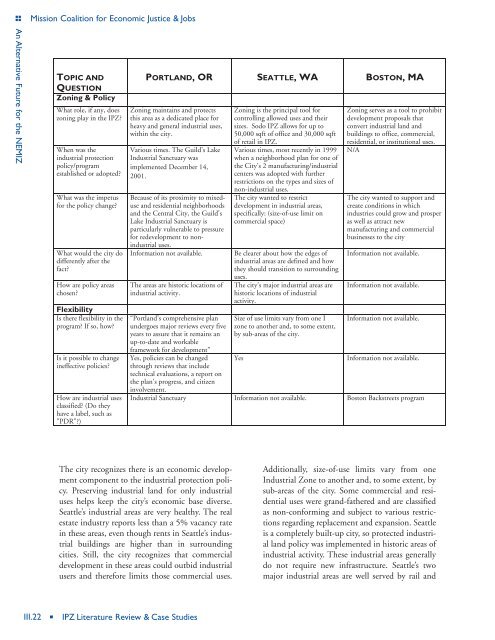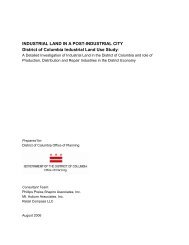An Alternative Future for the North East Mission Industrial Zone
An Alternative Future for the North East Mission Industrial Zone
An Alternative Future for the North East Mission Industrial Zone
Create successful ePaper yourself
Turn your PDF publications into a flip-book with our unique Google optimized e-Paper software.
<strong>An</strong> <strong>Alternative</strong> <strong>Future</strong> <strong>for</strong> <strong>the</strong> NEMIZ<br />
<strong>Mission</strong> Coalition <strong>for</strong> Economic Justice & Jobs<br />
TOPIC AND<br />
QUESTION<br />
Zoning & Policy<br />
What role, if any, does<br />
zoning play in <strong>the</strong> IPZ?<br />
When was <strong>the</strong><br />
industrial protection<br />
policy/program<br />
established or adopted?<br />
What was <strong>the</strong> impetus<br />
<strong>for</strong> <strong>the</strong> policy change?<br />
What would <strong>the</strong> city do<br />
differently after <strong>the</strong><br />
fact?<br />
How are policy areas<br />
chosen?<br />
Flexibility<br />
Is <strong>the</strong>re flexibility in <strong>the</strong><br />
program? If so, how?<br />
Is it possible to change<br />
ineffective policies?<br />
How are industrial uses<br />
classified? (Do <strong>the</strong>y<br />
have a label, such as<br />
"PDR"?)<br />
The city recognizes <strong>the</strong>re is an economic development<br />
component to <strong>the</strong> industrial protection policy.<br />
Preserving industrial land <strong>for</strong> only industrial<br />
uses helps keep <strong>the</strong> city’s economic base diverse.<br />
Seattle’s industrial areas are very healthy. The real<br />
estate industry reports less than a 5% vacancy rate<br />
in <strong>the</strong>se areas, even though rents in Seattle’s industrial<br />
buildings are higher than in surrounding<br />
cities. Still, <strong>the</strong> city recognizes that commercial<br />
development in <strong>the</strong>se areas could outbid industrial<br />
users and <strong>the</strong>re<strong>for</strong>e limits those commercial uses.<br />
III.22 IPZ Literature Review & Case Studies<br />
PORTLAND, OR SEATTLE, WA BOSTON, MA<br />
Zoning maintains and protects<br />
this area as a dedicated place <strong>for</strong><br />
heavy and general industrial uses,<br />
within <strong>the</strong> city.<br />
Various times. The Guild’s Lake<br />
<strong>Industrial</strong> Sanctuary was<br />
implemented December 14,<br />
2001.<br />
Because of its proximity to mixeduse<br />
and residential neighborhoods<br />
and <strong>the</strong> Central City, <strong>the</strong> Guild's<br />
Lake <strong>Industrial</strong> Sanctuary is<br />
particularly vulnerable to pressure<br />
<strong>for</strong> redevelopment to non-<br />
industrial uses.<br />
Zoning is <strong>the</strong> principal tool <strong>for</strong><br />
controlling allowed uses and <strong>the</strong>ir<br />
sizes. Sodo IPZ allows <strong>for</strong> up to<br />
50,000 sqft of office and 30,000 sqft<br />
of retail in IPZ.<br />
Various times, most recently in 1999<br />
when a neighborhood plan <strong>for</strong> one of<br />
<strong>the</strong> City’s 2 manufacturing/industrial<br />
centers was adopted with fur<strong>the</strong>r<br />
restrictions on <strong>the</strong> types and sizes of<br />
non-industrial uses.<br />
The city wanted to restrict<br />
development in industrial areas,<br />
specifically: (size-of-use limit on<br />
commercial space)<br />
In<strong>for</strong>mation not available. Be clearer about how <strong>the</strong> edges of<br />
industrial areas are defined and how<br />
<strong>the</strong>y should transition to surrounding<br />
The areas are historic locations of<br />
industrial activity.<br />
“Portland’s comprehensive plan<br />
undergoes major reviews every five<br />
years to assure that it remains an<br />
up-to-date and workable<br />
framework <strong>for</strong> development”<br />
uses.<br />
The city’s major industrial areas are<br />
historic locations of industrial<br />
activity.<br />
Size of use limits vary from one I<br />
zone to ano<strong>the</strong>r and, to some extent,<br />
by sub-areas of <strong>the</strong> city.<br />
Zoning serves as a tool to prohibit<br />
development proposals that<br />
convert industrial land and<br />
buildings to office, commercial,<br />
residential, or institutional uses.<br />
N/A<br />
The city wanted to support and<br />
create conditions in which<br />
industries could grow and prosper<br />
as well as attract new<br />
manufacturing and commercial<br />
businesses to <strong>the</strong> city<br />
In<strong>for</strong>mation not available.<br />
In<strong>for</strong>mation not available.<br />
In<strong>for</strong>mation not available.<br />
Yes, policies can be changed<br />
through reviews that include<br />
technical evaluations, a report on<br />
<strong>the</strong> plan’s progress, and citizen<br />
involvement.<br />
Yes In<strong>for</strong>mation not available.<br />
<strong>Industrial</strong> Sanctuary In<strong>for</strong>mation not available. Boston Backstreets program<br />
Additionally, size-of-use limits vary from one<br />
<strong>Industrial</strong> <strong>Zone</strong> to ano<strong>the</strong>r and, to some extent, by<br />
sub-areas of <strong>the</strong> city. Some commercial and residential<br />
uses were grand-fa<strong>the</strong>red and are classified<br />
as non-con<strong>for</strong>ming and subject to various restrictions<br />
regarding replacement and expansion. Seattle<br />
is a completely built-up city, so protected industrial<br />
land policy was implemented in historic areas of<br />
industrial activity. These industrial areas generally<br />
do not require new infrastructure. Seattle’s two<br />
major industrial areas are well served by rail and












